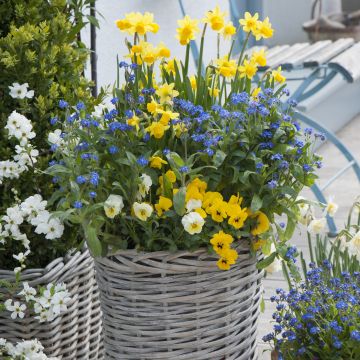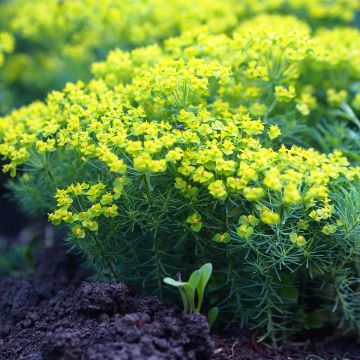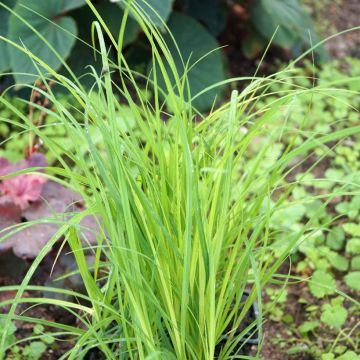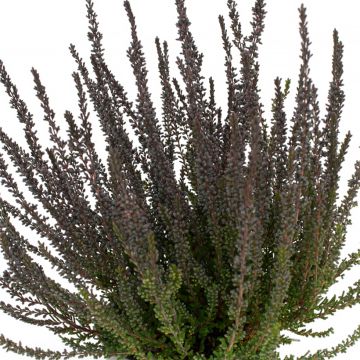Shipping country and language
Your country of residence may be:
Your country of residence is:
For a better user experience on our website, you can select:
Your shipping country:
Andorra
Austria
Belgium
Bulgaria
Canada
Chile
Croatia
Cyprus
Czechia
Denmark
Estonia
Finland
France
Germany
Greece
Hungary
Iceland
Ireland
Italy
Latvia
Lithuania
Luxembourg
Malta
Monaco
Netherlands
Poland
Portugal
Romania
Slovakia
Slovenia
Spain
Sweden
Switzerland
United Kingdom
We only deliver seed and bulb products to your country. If you add other products to your basket, they cannot be shipped.
Language:
French
German
Spanish
English
My Account
Hello
My wish lists
Plantfit
Log in / Register
Existing customer?
New customer?
Create an account to track your orders, access our customer service and, if you wish, make the most of our upcoming offers.


Impatiens omeiana Ice Storm


Impatiens omeiana Ice Storm
Impatiens omeiana Ice Storm
Impatiens omeiana Ice Storm
Hardy Impatiens, Mount Omei Busy Lizzie, Mount Omei Balsam
Impatiens received in very bad condition and also sick. Disease of brown spot covering more than 75% of the leaves... I hope to be able to save it but at this stage, I highly doubt it... very disappointed.
Esmeralda, 30/10/2023
Order in the next for dispatch today!
Dispatch by letter from 3,90 €.
Delivery charge from 5,90 € Oversize package delivery charge from 6,90 €.
More information
This item is not available in your country.
Shipping country:
Andorra
Austria
Belgium
Bulgaria
Canada
Chile
Croatia
Cyprus
Czechia
Denmark
Estonia
Finland
France
Germany
Greece
Hungary
Iceland
Ireland
Italy
Latvia
Lithuania
Luxembourg
Malta
Monaco
Netherlands
Poland
Portugal
Romania
Slovakia
Slovenia
Spain
Sweden
Switzerland
United Kingdom
Schedule delivery date,
and select date in basket
This plant carries a 12 months recovery warranty
More information
We guarantee the quality of our plants for a full growing cycle, and will replace at our expense any plant that fails to recover under normal climatic and planting conditions.
From 5,90 € for pickup delivery and 6,90 € for home delivery
Express home delivery from 8,90 €.
Would this plant suit my garden?
Set up your Plantfit profile →
Description
Impatiens omeiana Ice Storm is a very beautiful variety with silver-speckled foliage of a botanical balsam species native to Mount Omei in the Chinese province of Sichuan. This small perennial and hardy plant forms a low bushy clump, carpeting the ground with exotic-looking vegetation that appears to be covered in frost. In late summer, its curious translucent flowers in the shape of a cornucopia, in two shades of yellow, appear in clusters. This impatiens is beautifully bright in the semi-shaded or shaded areas it prefers. It thrives when planted in a humus-rich, light, fertile soil that remains moist to wet in summer.
The Impatiens omeiana Ice Storm is a perennial plant belonging to the Balsaminaceae family, just like the impatiens we grow as annuals on our terraces and balconies. Its ancestor was discovered in 1983 in western China, on Mount Omei. This species, fairly easy to cultivate if the right conditions are met, is rare in cultivation and on the verge of extinction in its native lands. The plant has a rhizomatous root system that allows it to slowly spread outwards on the ground. It forms a bushy clump that reaches 35-45cm (14-18in) in height, with a spread of about 90cm (35in). The foliage emerges from the ground in spring and disappears in winter. Its upright stems bear young leaves that are almost white and very decorative. They unfold into elongated, lanceolate leaves with pointed tips, dentate margins, and prominent veins. The dark greenish-blue leaf has beautiful white-silver reflections. Flowering occurs from September to October. The flowers take the form of flower spikes bearing clusters of small, elongated, tubular flowers with a curly spur filled with nectar. Suspended on a peduncle, they are mobile and sway in the slightest breeze. After pollination by insects, small seed heads form and explode when ripe, dispersing the seeds in the surroundings.
The Impatiens omeiana Ice Storm will delight gardeners who appreciate rare plants adapted to moist shaded areas. Its subtly exotic charm hides a surprising hardiness, and its cultivation is not difficult if one takes care to protect it from overly vigorous neighbours. It requires little maintenance, apart from careful watering. For example, it can be accompanied by small ferns, hostas, disporums, or heucheras.
Impatiens omeiana Ice Storm in pictures
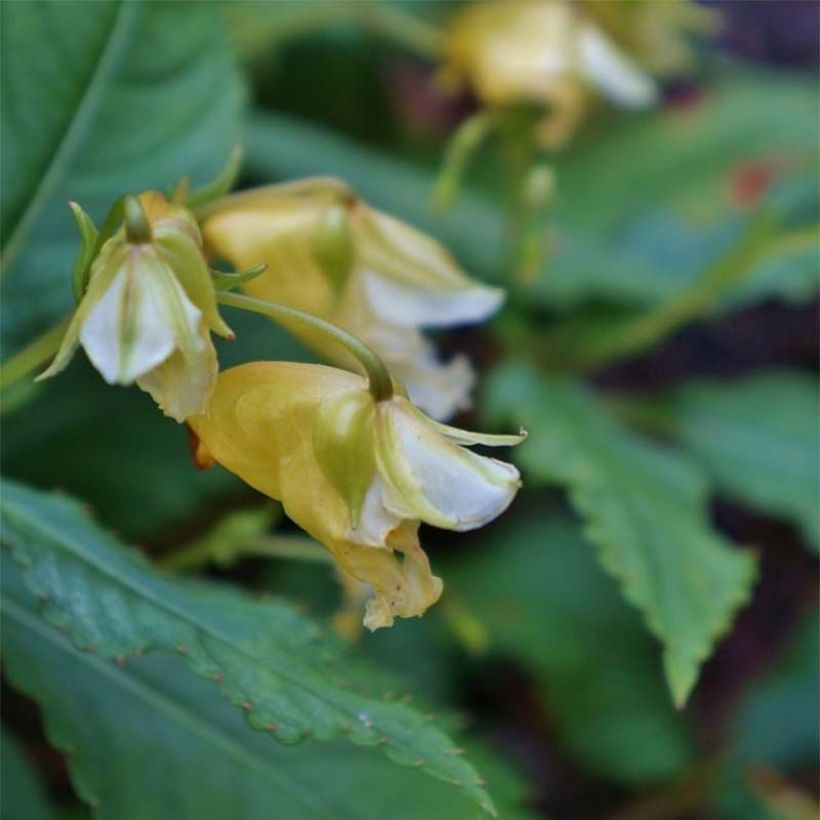



Flowering
Foliage
Plant habit
Botanical data
Impatiens
omeiana
Ice Storm
Balsaminaceae
Hardy Impatiens, Mount Omei Busy Lizzie, Mount Omei Balsam
Cultivar or hybrid
Other Perennials A to Z
Planting and care
Plant Impatiens omeiana Ice Storm in shade or partial shade, in humus-rich, fertile, very moist but well-drained soil, with a slightly acidic, neutral or slightly alkaline tendency. Excessively clayey soil can lead to root rot. Ensure that the soil remains moist even in summer. Make sure that other plants do not compete with it, and weed whenever necessary.
Planting period
Intended location
Care
- , onOrder confirmed
Reply from on Promesse de fleurs
Ground cover perennials
Haven't found what you were looking for?
Hardiness is the lowest winter temperature a plant can endure without suffering serious damage or even dying. However, hardiness is affected by location (a sheltered area, such as a patio), protection (winter cover) and soil type (hardiness is improved by well-drained soil).

Photo Sharing Terms & Conditions
In order to encourage gardeners to interact and share their experiences, Promesse de fleurs offers various media enabling content to be uploaded onto its Site - in particular via the ‘Photo sharing’ module.
The User agrees to refrain from:
- Posting any content that is illegal, prejudicial, insulting, racist, inciteful to hatred, revisionist, contrary to public decency, that infringes on privacy or on the privacy rights of third parties, in particular the publicity rights of persons and goods, intellectual property rights, or the right to privacy.
- Submitting content on behalf of a third party;
- Impersonate the identity of a third party and/or publish any personal information about a third party;
In general, the User undertakes to refrain from any unethical behaviour.
All Content (in particular text, comments, files, images, photos, videos, creative works, etc.), which may be subject to property or intellectual property rights, image or other private rights, shall remain the property of the User, subject to the limited rights granted by the terms of the licence granted by Promesse de fleurs as stated below. Users are at liberty to publish or not to publish such Content on the Site, notably via the ‘Photo Sharing’ facility, and accept that this Content shall be made public and freely accessible, notably on the Internet.
Users further acknowledge, undertake to have ,and guarantee that they hold all necessary rights and permissions to publish such material on the Site, in particular with regard to the legislation in force pertaining to any privacy, property, intellectual property, image, or contractual rights, or rights of any other nature. By publishing such Content on the Site, Users acknowledge accepting full liability as publishers of the Content within the meaning of the law, and grant Promesse de fleurs, free of charge, an inclusive, worldwide licence for the said Content for the entire duration of its publication, including all reproduction, representation, up/downloading, displaying, performing, transmission, and storage rights.
Users also grant permission for their name to be linked to the Content and accept that this link may not always be made available.
By engaging in posting material, Users consent to their Content becoming automatically accessible on the Internet, in particular on other sites and/or blogs and/or web pages of the Promesse de fleurs site, including in particular social pages and the Promesse de fleurs catalogue.
Users may secure the removal of entrusted content free of charge by issuing a simple request via our contact form.
The flowering period indicated on our website applies to countries and regions located in USDA zone 8 (France, the United Kingdom, Ireland, the Netherlands, etc.)
It will vary according to where you live:
- In zones 9 to 10 (Italy, Spain, Greece, etc.), flowering will occur about 2 to 4 weeks earlier.
- In zones 6 to 7 (Germany, Poland, Slovenia, and lower mountainous regions), flowering will be delayed by 2 to 3 weeks.
- In zone 5 (Central Europe, Scandinavia), blooming will be delayed by 3 to 5 weeks.
In temperate climates, pruning of spring-flowering shrubs (forsythia, spireas, etc.) should be done just after flowering.
Pruning of summer-flowering shrubs (Indian Lilac, Perovskia, etc.) can be done in winter or spring.
In cold regions as well as with frost-sensitive plants, avoid pruning too early when severe frosts may still occur.
The planting period indicated on our website applies to countries and regions located in USDA zone 8 (France, United Kingdom, Ireland, Netherlands).
It will vary according to where you live:
- In Mediterranean zones (Marseille, Madrid, Milan, etc.), autumn and winter are the best planting periods.
- In continental zones (Strasbourg, Munich, Vienna, etc.), delay planting by 2 to 3 weeks in spring and bring it forward by 2 to 4 weeks in autumn.
- In mountainous regions (the Alps, Pyrenees, Carpathians, etc.), it is best to plant in late spring (May-June) or late summer (August-September).
The harvesting period indicated on our website applies to countries and regions in USDA zone 8 (France, England, Ireland, the Netherlands).
In colder areas (Scandinavia, Poland, Austria...) fruit and vegetable harvests are likely to be delayed by 3-4 weeks.
In warmer areas (Italy, Spain, Greece, etc.), harvesting will probably take place earlier, depending on weather conditions.
The sowing periods indicated on our website apply to countries and regions within USDA Zone 8 (France, UK, Ireland, Netherlands).
In colder areas (Scandinavia, Poland, Austria...), delay any outdoor sowing by 3-4 weeks, or sow under glass.
In warmer climes (Italy, Spain, Greece, etc.), bring outdoor sowing forward by a few weeks.
